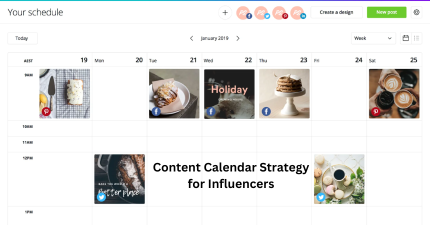
- 29 Oct, 2024
Finding Your Perfect Match: A Step-by-Step Guide to Choosing the Right Influencer for Your Brand
In today’s digital age, where social media reigns supreme, the right influencer can transform your brand from a hidden gem into a household name. But with an ocean of influencers out there—each boasting their unique style, audience, and engagement strategies—how do you find that perfect match? Fear not! Whether you're looking to elevate your product launch or amplify your brand message, our comprehensive step-by-step guide will walk you through the process of selecting an influencer who embodies your values and resonates with your target audience. Buckle up as we delve into the art of influencer selection; it’s time to discover how aligning with the right voice can unlock new heights for your brand!
Introduction to Influencer Marketing
Influencer marketing has transformed the way brands connect with their audiences. It’s no longer just about traditional advertising; it’s about authentic relationships and genuine recommendations. With social media platforms bustling with influencers, businesses have a unique opportunity to tap into these vibrant networks.
But finding the right influencer for your brand can feel like searching for a needle in a haystack. The stakes are high, as choosing an influencer who doesn’t align with your values or audience can lead to wasted resources and missed opportunities. So, how do you navigate this ever-evolving landscape?
This step-by-step guide will help you pinpoint that perfect match—an influencer who resonates with your target market and embodies your brand's ethos. Get ready to unlock the full potential of influencer collaborations!
Why Choosing the Right Influencer is Important
Selecting the right influencer can make or break your marketing campaign. An influencer aligned with your brand's values will resonate more authentically with their audience.
When you partner with an influencer who truly understands and embodies your message, it fosters trust. Their followers often view them as credible sources of information. This connection leads to higher engagement rates, driving better results for your campaigns.
Additionally, mismatched partnerships can dilute your brand image. If an influencer’s content style or ethos clashes with yours, potential customers may become confused about what you stand for.
Moreover, choosing wisely helps optimize budget allocation. Collaborating with influencers who genuinely connect enhances return on investment while minimizing wasted resources on ineffective promotions.
The right fit not only boosts visibility but also cultivates a loyal community around your brand. Genuine connections fostered through authenticity lead to long-lasting relationships that benefit everyone involved.
Identifying Your Target Audience and Brand Values
Understanding your target audience is the cornerstone of any successful marketing strategy. Start by analyzing demographics like age, gender, and location. These factors will help you tailor your messages effectively.
Next, delve deeper into psychographics. What are their interests, hobbies, and values? Knowing what resonates with them can influence your choice of influencer.
Your brand values should align closely with those of your audience. If sustainability matters to your customers, collaborate with influencers who champion eco-friendly practices.
The right partnership feels authentic both ways; it speaks to shared beliefs and goals.
Also, consider how these elements intersect with current trends. Staying attuned to societal shifts can enhance relatability in a crowded market.
Investing time in this research not only shapes effective campaigns but also fosters genuine connections between brands and consumers.
Types of Influencers: Micro, Macro, and Mega
Influencers come in various shapes and sizes. Understanding these types can elevate your marketing strategy.
Micro-influencers usually have between 1,000 to 100,000 followers. They often cultivate a tight-knit community. Their audience trusts them deeply, leading to higher engagement rates.
Macro-influencers possess a broader reach with follower counts ranging from 100,000 to 1 million. They strike a balance between influence and authenticity but may be less accessible than micro counterparts.
Mega-influencers are the celebrities of the digital world. With millions of followers, they offer immense visibility for brands. However, their wide-reaching appeal can sometimes dilute personal connections with their audience.
Each type has its unique strengths and suits different campaign goals. Choosing wisely based on your brand's needs is key in influencer partnerships.
How to Find Potential Influencers
Finding potential influencers starts with research. Begin by exploring social media platforms like Instagram, TikTok, and YouTube. Use hashtags related to your niche to uncover creators who resonate with your brand.
Next, leverage influencer discovery tools such as BuzzSumo or AspireIQ. These platforms allow you to filter based on engagement rates and audience demographics.
Don’t overlook micro-influencers. They often have loyal followers who trust their recommendations more than those of larger accounts.
Engage in online communities relevant to your industry too. Forums and Facebook groups can lead you to hidden gems that might align perfectly with your values.
Finally, keep an eye on content quality and relevance. Look for influencers whose message echoes yours while maintaining a unique voice that connects authentically with their audience.
Evaluating an Influencer's Engagement and Authenticity
When selecting an influencer, engagement and authenticity are paramount. Numbers can be misleading; a high follower count doesn't guarantee effective marketing.
Look beyond likes and shares. Examine comments to see if the audience interacts meaningfully. Genuine connections show that followers trust the influencer's opinion.
Authenticity also shines through storytelling. Influencers who share personal experiences or values resonate more with their audiences. Check for consistency in their messaging across platforms—this builds credibility.
Another vital aspect is how influencers handle sponsored content. Those who maintain transparency about partnerships often foster stronger relationships with their followers.
Finally, consider the quality of interactions over quantity. A few thoughtful comments from engaged fans can indicate a loyal following far more than thousands of superficial likes ever could.
Negotiating and Setting Expectations with an Influencer
Negotiating with an influencer is a critical step that can shape your campaign's success. Clear communication sets the foundation for a fruitful collaboration.
Start by discussing deliverables. Outline what you expect in terms of posts, stories, or videos. Specify formats and platforms to avoid misunderstandings later on.
Budget plays a significant role too. Be transparent about your financial limits while being open to their rates and potential value. This helps in finding common ground.
Timing matters as well. Set deadlines for content creation, review periods, and publishing dates to ensure everything flows smoothly.
Don’t forget about brand alignment. Share your values and vision so the influencer captures your essence authentically in their work.
Lastly, establish metrics for evaluating performance early on. Agreeing on KPIs lets both parties understand what success looks like from the start without ambiguity lingering over the partnership.
Measuring the Success of Your Partnership with an Influencer
Measuring the success of an influencer partnership goes beyond tracking likes and follows. It’s about understanding how well your brand message resonated with the audience.
Start by setting clear goals before launching a campaign. Are you aiming for increased sales, brand awareness, or social engagement? Defining these metrics will guide your evaluation process.
Engagement rates reveal how interactive the audience was with the content. Look at comments, shares, and overall sentiment to gauge impact. Positive interactions indicate a strong alignment between the influencer's voice and your brand.
Tracking referral traffic can also provide insights into conversion effectiveness. Use unique links or promo codes to see how many users engage after interacting with influencer content.
Don't forget qualitative feedback too. Gather insights from customer responses and press mentions to understand broader perceptions caused by the collaboration. Each metric contributes valuable information that shapes future strategies.
Case Studies: Successful Brand-Influencer Collaborations
One of the most striking examples of effective brand-influencer collaboration is Daniel Wellington. The watch brand skyrocketed to fame through partnerships with numerous influencers across various social media platforms. By encouraging these influencers to share pictures wearing their products, they created a buzz that turned into significant sales.
Another notable case is Glossier, a beauty brand that thrives on authenticity. They worked with micro-influencers who genuinely loved the products. These collaborations felt natural and aligned perfectly with Glossier’s ethos, leading to organic growth and loyal customers.
Fitness apparel company Gymshark also made waves by leveraging fitness enthusiasts on Instagram and YouTube. Their strategy involved not just promoting products but building a community around shared values of health and wellness.
These examples illustrate how thoughtful collaborations can resonate deeply with audiences, driving engagement and fostering loyalty in ways traditional advertising often cannot achieve.
Tips for Maintaining a Long-Term Relationship with an Influencer
Building a lasting relationship with an influencer requires ongoing communication. Check-in regularly to share updates and feedback, fostering a sense of collaboration.
Show appreciation for their work. A simple thank-you or recognition can go a long way. Influencers thrive on positive reinforcement, so celebrate milestones together.
Be transparent about your goals and expectations from the start. Clarity helps avoid misunderstandings later.
Encourage creativity by allowing influencers to express themselves freely in campaigns. Their unique voice is what resonates with their audience.
Offer exclusive opportunities or incentives that align with their interests and values. This demonstrates commitment beyond just financial gain.
Lastly, nurture personal connections when appropriate. Understanding each other’s passions can help strengthen your partnership over time, making it more meaningful and effective for both sides.
The Importance of Authenticity in Influencer Marketing
Authenticity plays a crucial role in influencer marketing. Brands must align themselves with influencers who genuinely resonate with their products or services. When an influencer authentically believes in what they are promoting, it reflects in their content and engagement.
Consumers today value transparency. They can easily spot insincerity or forced endorsements. This is why it's vital to choose influencers whose values align with your brand's mission and ethos. The right partnership fosters trust, which ultimately leads to increased brand loyalty.
Building long-term relationships based on authenticity not only enhances credibility but also benefits both parties involved. An authentic connection can drive higher engagement rates and foster community among followers.
Investing time into finding the perfect influencer for your brand will pay off significantly down the line—both for sales figures and brand reputation. Prioritize genuine connections, and watch your influence grow organically within your target market.




